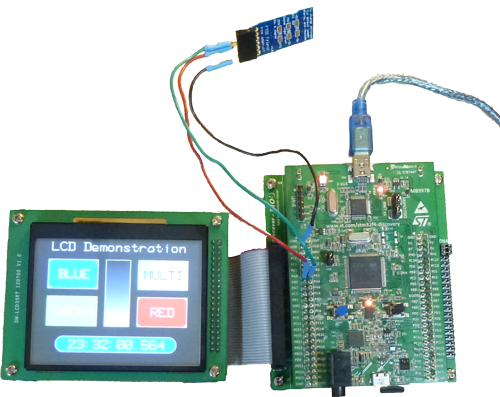In this
article:
Specs and Features
Navigation:
HomeHardware
Software
Techniques
Controllers
Reviews
Index
Introduction
ST Micro came out with a board to show off their ARM Cortex-M4 offering, the STM32F4 processor. This processor has 1MB of flash and 122K of RAM on it which makes it fairly powerful for a Robotic system. The eval board (without the expansion boards) was $14.95 quantity one when it came out. This generated a lot of excitement in the robotics community.
The Board
Shown above is the STM32F4-Discovery running a simple LCD Demo I wrote for it. Normally powered by the USB port on the top, this USB port is connected to an ARM Cortex-M0 chip that is running the ST-Link protocol. That lets you download and debug programs from a Windows platform machine.
Attached to the PA2/PA3 pins is an AdaFruit FTDI Board which is acting as a serial port. You can’t see it from the picture but underneath the Eval board there is an STM32F4-BB “base board” from Embest which has an RS–232 interface built into it but the DB–9 connector is “PC-Standard” so it thinks it is a PC, to connect to a PC you need both a gender changer and a null modem.
The Discovery board uses the 100 pin TQFP version of the chip so ports F and G (32 total I/O’s) are not available, still it does have the ability to do Ethernet which sets it apart from other boards. I expect to have a series of articles up on the site describing things I’ve done with this board.
Specs and Features
The chip has a USB OTG capability, as well as an Ethernet MAC that is capable of 10/100 speeds (dedicated DMA channel). SDIO for connecting an SD card is also provided as well as a digital camera interface. (This chip is apparently used in some budget point and shoot cameras).
| Manufacturer : | ST Micro |
|---|---|
| ISA : | 32 bit ARM Cortex M4 |
| Analog I/O : |
3 ch 12 bits 2.4 Msps |
| Clock Frequency : |
168Mhz |
| Digital I/O : |
64 in 64 out |
| Ethernet : |
10/100 RMII |
| Memory : |
122K RAM 1MB Flash |
| Serial I/O : |
4 UART 3 SPI 2 CAN |
| Timer I/O : |
17 GP 4 PWM 4 IC 4 OC |
|
Note: some pins may be multiplexed, consult the chip datasheet for specific pin counts and usage. |
|
